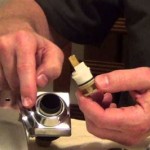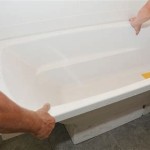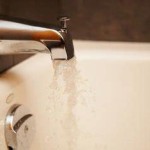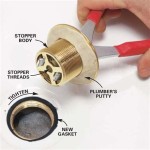```html
Oversized Bathtub Overflow Cover Plate Replacement: A Comprehensive Guide
The bathtub overflow cover plate, often a small and seemingly insignificant component, plays a crucial role in preventing water damage within a bathroom. It serves as a safety mechanism, allowing excess water to drain away before it overflows the tub's rim. Over time, these plates can become damaged, corroded, or simply aesthetically unappealing, necessitating replacement. When dealing with oversized or uniquely designed bathtubs, finding a suitable replacement can present a unique set of challenges. This article provides a comprehensive guide to understanding, selecting, and replacing an oversized bathtub overflow cover plate.
Understanding the function of the overflow cover plate is fundamental to appreciating its importance. The plate is typically mounted near the top of the bathtub, either directly to the tub wall or integrated with the drain lever mechanism. Behind the plate is an overflow pipe that connects to the main drain line. When the water level rises too high during bathing, the excess water flows into the overflow pipe and is safely directed down the drain. Without a functioning overflow system, the bathtub would be susceptible to overflowing, leading to potential water damage to the bathroom floor, walls, and even adjacent rooms.
Oversized bathtubs, particularly those found in older homes or those with unique architectural designs, often feature overflow cover plates that deviate from the standard sizes commonly available at hardware stores. These oversized plates are frequently custom-made or sourced from specialized manufacturers. Finding an exact match can be difficult, but understanding the dimensions and mounting style of the existing plate is crucial when searching for a replacement.
Identifying the Need for Replacement
Several indicators suggest that an oversized bathtub overflow cover plate requires replacement. Obvious signs include visible damage such as cracks, chips, or significant corrosion. These damages compromise the integrity of the plate and can hinder its ability to effectively seal the overflow drain, potentially leading to leaks. A plate that is severely corroded may also become difficult to remove for cleaning or maintenance purposes.
Beyond physical damage, aesthetic considerations can also drive the decision to replace the overflow cover plate. If the plate is significantly discolored, stained, or simply clashes with the bathroom's overall décor, replacing it with a more suitable option can enhance the visual appeal of the space. This is especially relevant in bathrooms undergoing renovation or remodeling.
Another reason for replacement is related to functionality. If the overflow drain is frequently clogged or drains slowly, the cover plate and its associated mechanism might be contributing to the problem. Mineral buildup or debris can accumulate around the plate and within the overflow pipe, restricting water flow. While cleaning may temporarily alleviate the issue, replacement may be necessary if the problem persists or if the existing plate is difficult to disassemble and clean thoroughly.
Measuring and Selecting a Replacement Oversized Overflow Cover Plate
Accurate measurement is paramount when sourcing a replacement for an oversized bathtub overflow cover plate. Begin by carefully measuring the diameter of the existing plate. If the plate is not perfectly circular, measure the longest dimension across the plate. Additionally, note the distance between the mounting screw holes. This measurement ensures that the replacement plate will align correctly with the existing mounting points on the bathtub wall.
Pay close attention to the mounting style of the existing plate. Some plates are directly screwed onto the tub wall, while others are integrated with the drain lever mechanism. If the plate is part of a drain lever assembly, carefully examine the connection points and the overall design of the mechanism. It may be necessary to replace the entire drain lever assembly along with the cover plate to ensure compatibility.
When searching for a replacement, consider exploring specialized plumbing supply stores or online retailers that cater to vintage or custom bathroom fixtures. These suppliers often carry a wider selection of oversized or uniquely designed overflow cover plates than traditional hardware stores. Be prepared to provide detailed measurements and photographs of the existing plate to assist the supplier in identifying a suitable match.
The material of the replacement plate is also a crucial consideration. Common materials include chrome, brass, bronze, and stainless steel. Chrome-plated brass is a popular choice due to its durability and resistance to corrosion. However, solid brass or bronze offers superior corrosion resistance and can be particularly suitable for older homes with potentially corrosive water conditions. Stainless steel provides a modern aesthetic and is also highly resistant to corrosion. Select a material that complements the existing bathroom fixtures and aligns with the overall design aesthetic.
The Replacement Process: A Step-by-Step Guide
Replacing an oversized bathtub overflow cover plate is a relatively straightforward task that can typically be completed with basic plumbing tools. However, it is essential to exercise caution and follow the steps carefully to avoid damaging the bathtub or the surrounding plumbing.
Before starting, gather the necessary tools and materials. These typically include a screwdriver (usually a Phillips head), a soft cloth, a cleaning solution, and the replacement overflow cover plate. Turn off the water supply to the bathtub to prevent any accidental leaks during the replacement process. If the bathtub has a drain stopper, remove it to gain better access to the overflow drain.
Gently loosen and remove the screws that secure the existing overflow cover plate to the bathtub wall. If the screws are corroded or difficult to remove, apply a penetrating oil to loosen them. Allow the oil to sit for a few minutes before attempting to remove the screws again. Avoid using excessive force, as this could strip the screw heads or damage the surrounding surface.
Once the screws are removed, carefully detach the old overflow cover plate. If the plate is stuck, gently pry it loose with a flathead screwdriver, being careful not to scratch the bathtub surface. Clean the area around the overflow drain opening to remove any dirt, debris, or sealant residue. Use a soft cloth and a mild cleaning solution to thoroughly clean the surface. This ensures a clean and secure fit for the new overflow cover plate.
Carefully position the new oversized overflow cover plate over the overflow drain opening. Align the mounting screw holes with the existing holes on the bathtub wall. Insert the screws and tighten them securely, but avoid overtightening, which could crack the plate or damage the bathtub. Ensure that the plate is flush with the bathtub wall and that there are no gaps around the edges.
If the replacement overflow cover plate is integrated with a drain lever mechanism, carefully connect the linkage between the plate and the drain stopper. Ensure that the linkage operates smoothly and that the drain stopper opens and closes properly. Adjust the linkage as needed to achieve the desired functionality. Test the overflow drain by filling the bathtub to just below the overflow opening. Observe the water as it flows into the overflow drain. Ensure that the water drains smoothly and that there are no leaks around the overflow cover plate.
Addressing Potential Challenges
Several challenges can arise during the replacement process. One common issue is difficulty in removing the old screws due to corrosion or stripping of the screw heads. In such cases, consider using a screw extractor tool to remove the damaged screws. Alternatively, carefully drill out the screw head and then use pliers to remove the remaining screw shaft.
Another potential challenge is finding a replacement overflow cover plate that perfectly matches the dimensions and mounting style of the existing plate. If an exact match is unavailable, consider modifying the mounting holes slightly or using shims to achieve a secure and flush fit. In some cases, it may be necessary to consult with a professional plumber to fabricate a custom overflow cover plate.
Leaks around the overflow cover plate after installation can also be a concern. This can be due to an uneven surface on the bathtub wall or a poorly fitting plate. Apply a thin bead of plumbing sealant around the edge of the overflow drain opening before installing the new plate. This creates a watertight seal and prevents leaks. Ensure that the sealant is compatible with the bathtub material and that it is applied evenly.
```
Oversized Fit All Overflow Plate

Pf Waterworks Tub Magic Less Snap On Overflow Face Plate

Universal Oversized Waste Overflow Plate 3 5 Brushed Nickel

Watco Innovator Snap On Bathtub Overflow Plate Kit In Brushed Nickel 18009 Bn

Westbrass Universal 2 Hole Overflow Faceplate In Stainless Steel D329 20 The Home Depot

Westbrass Round Replacement Full Or Partial Closing Overflow In Polished Chrome D493ch 26 The Home Depot

Danco Single Hole Bathtub Drain Overflow Plate In Brushed Nickel 89235 At Com

P1 51 100

P1 51 100

1 Hole Bath Tub Overflow Faceplate Single Trim Bathtub Drain Over Flow Plate Cover With Matching And Adapter Universal Fits For Bathroom Replacing Plates Brushed Nickel Finish Com








